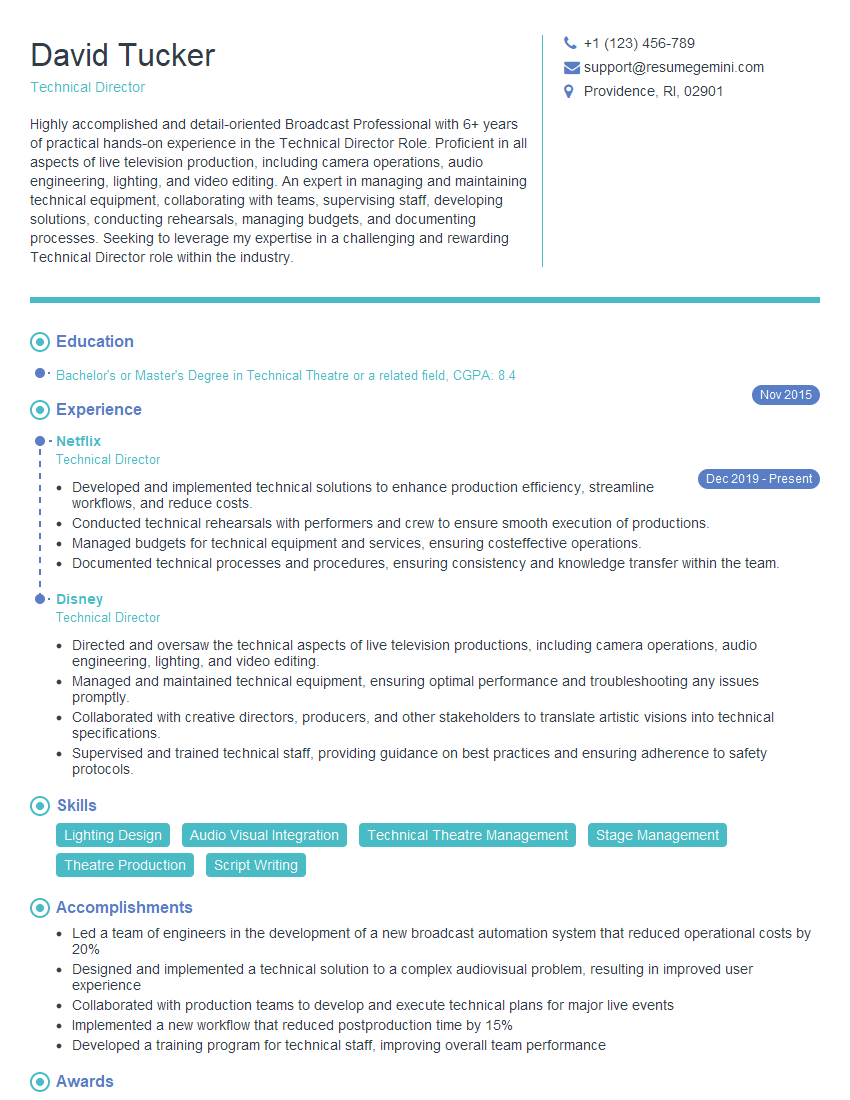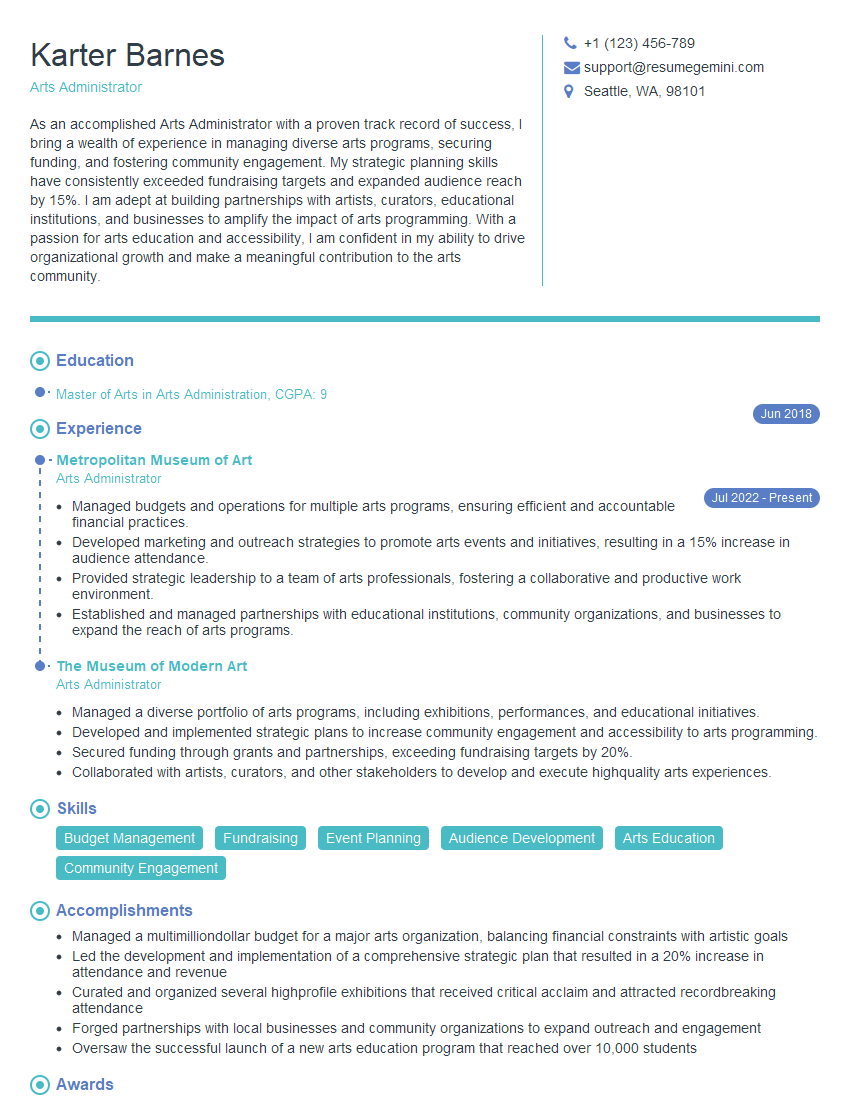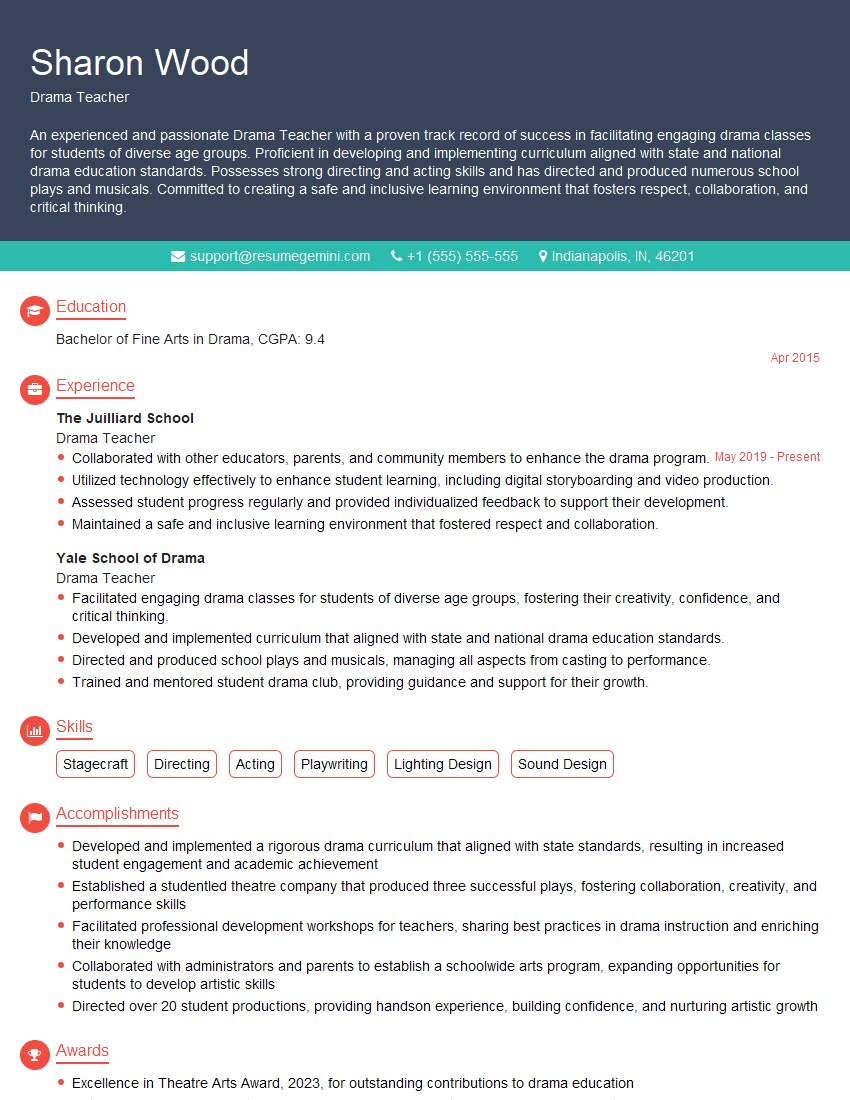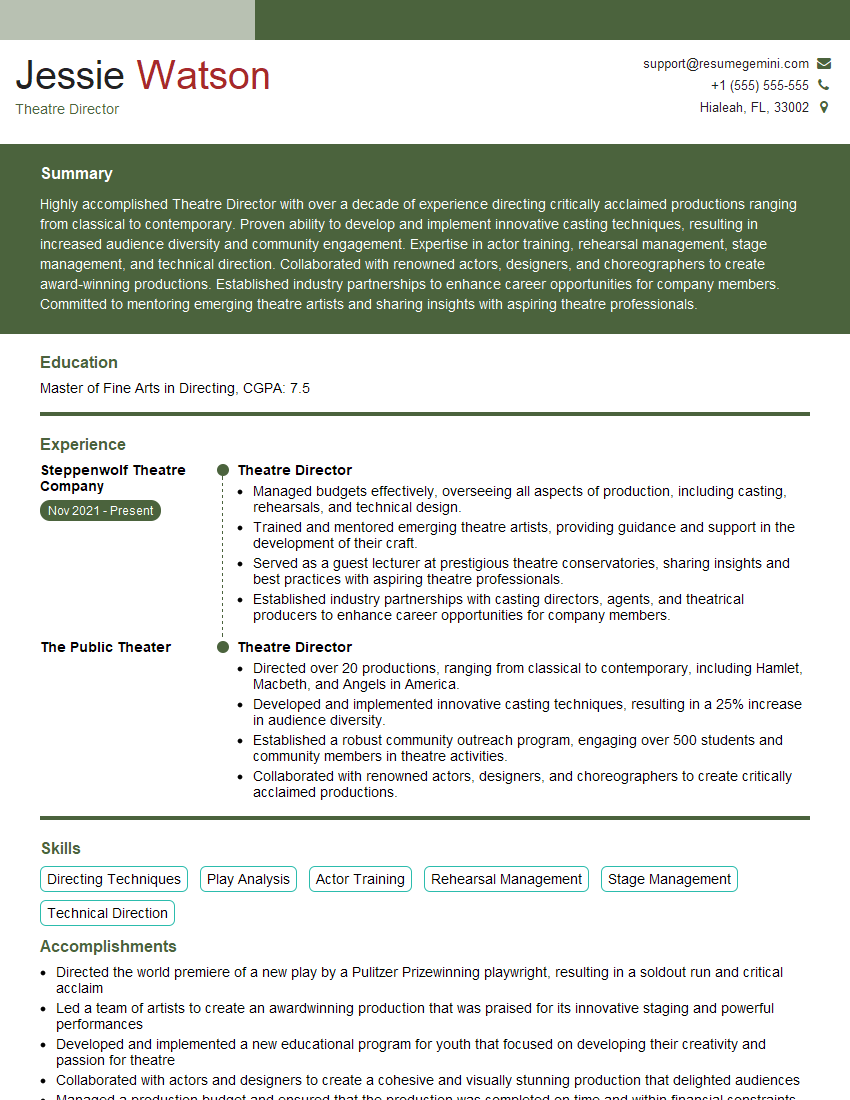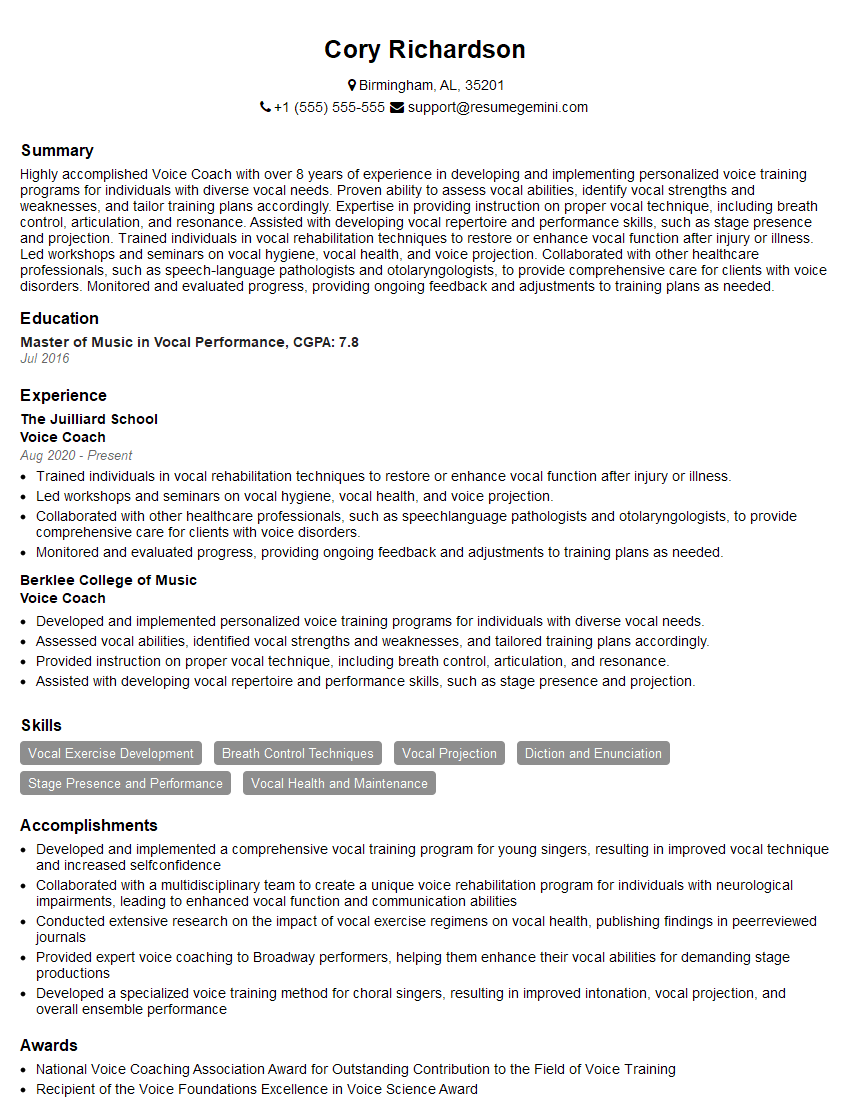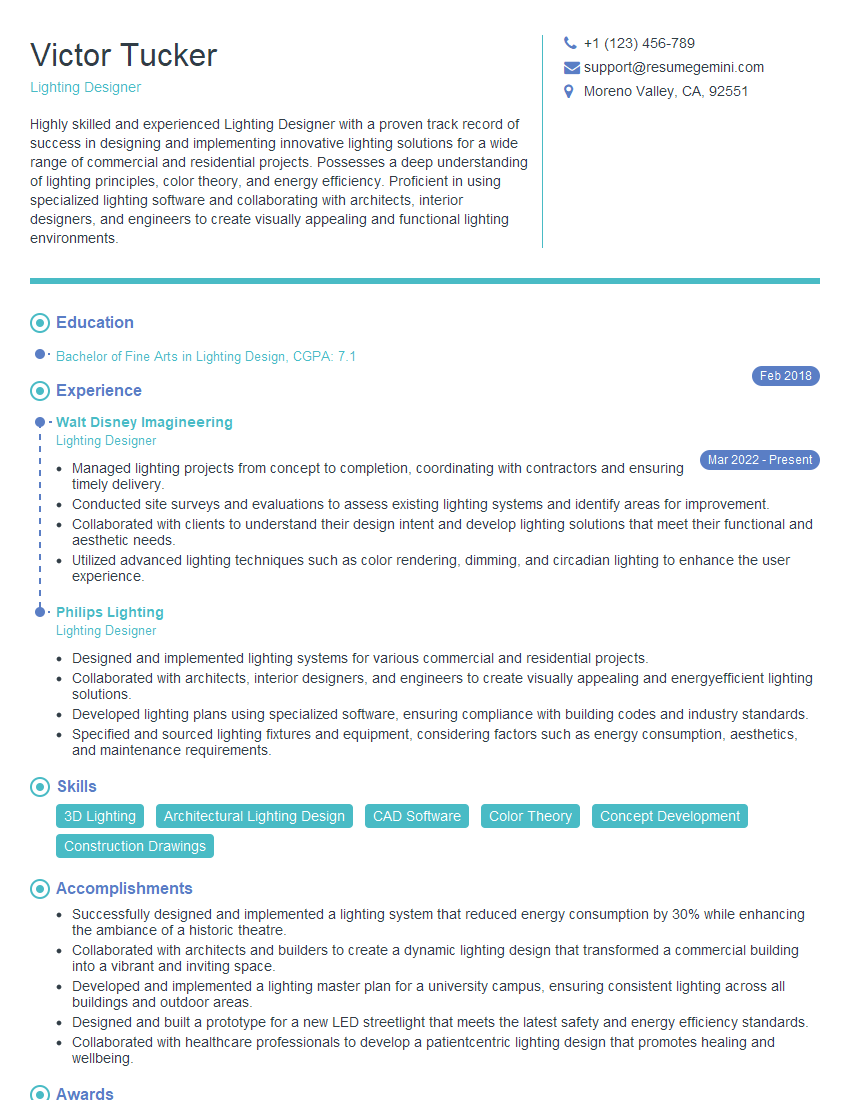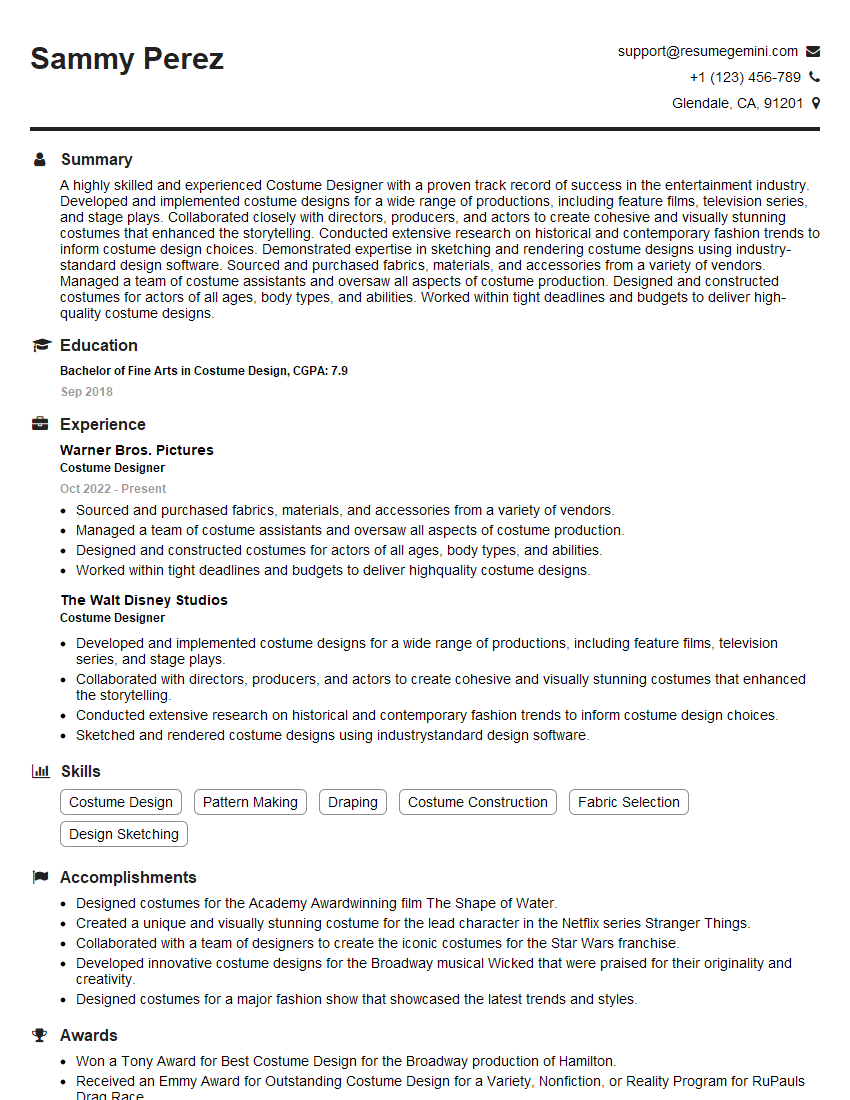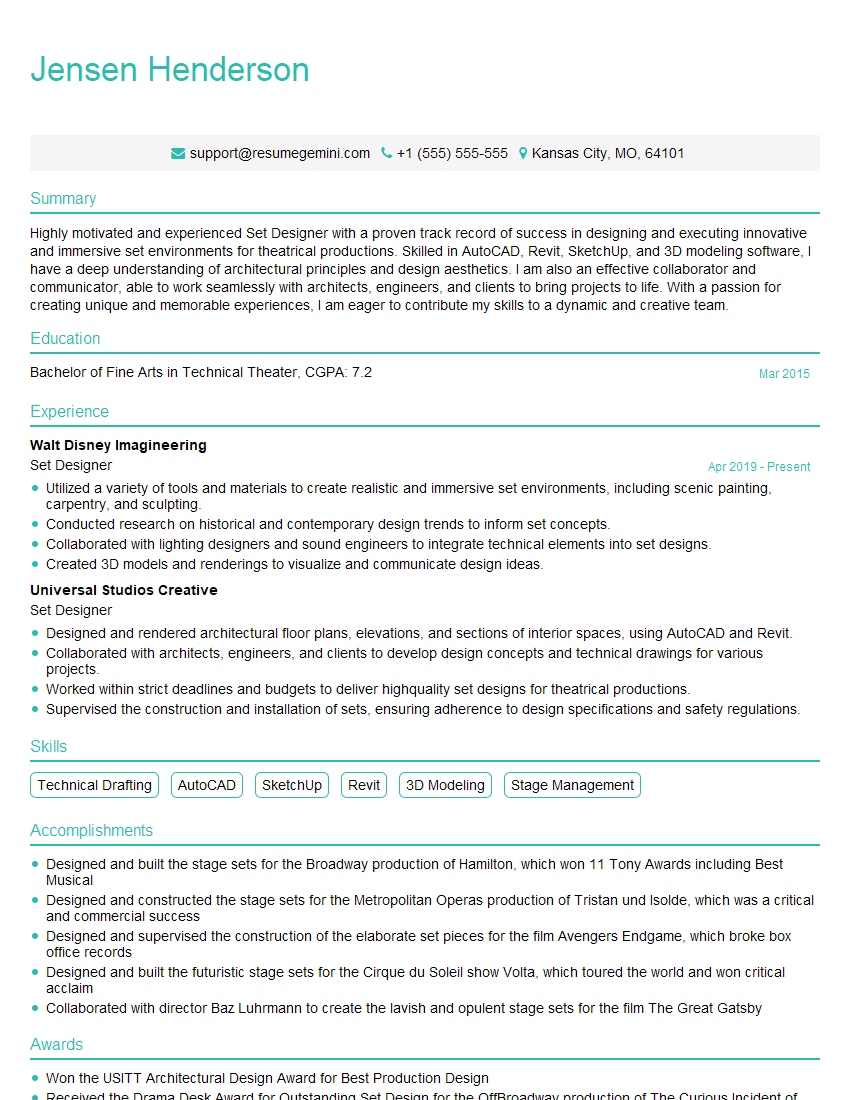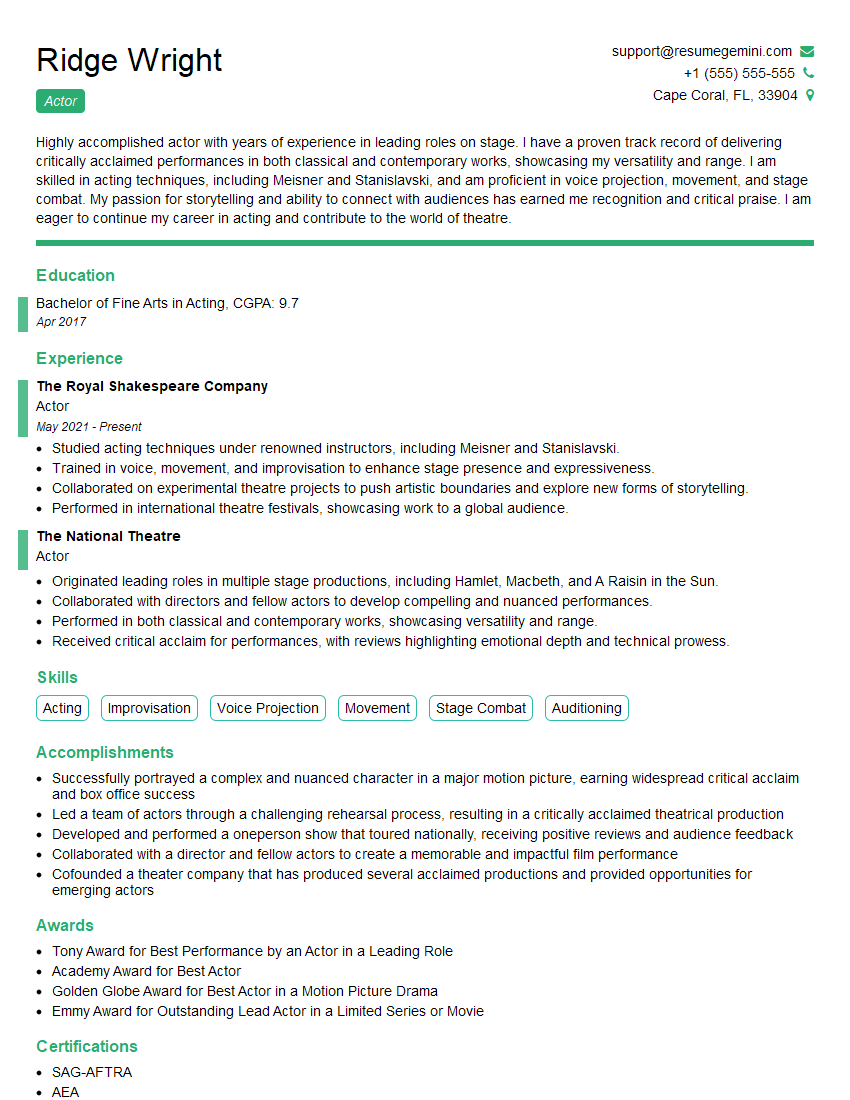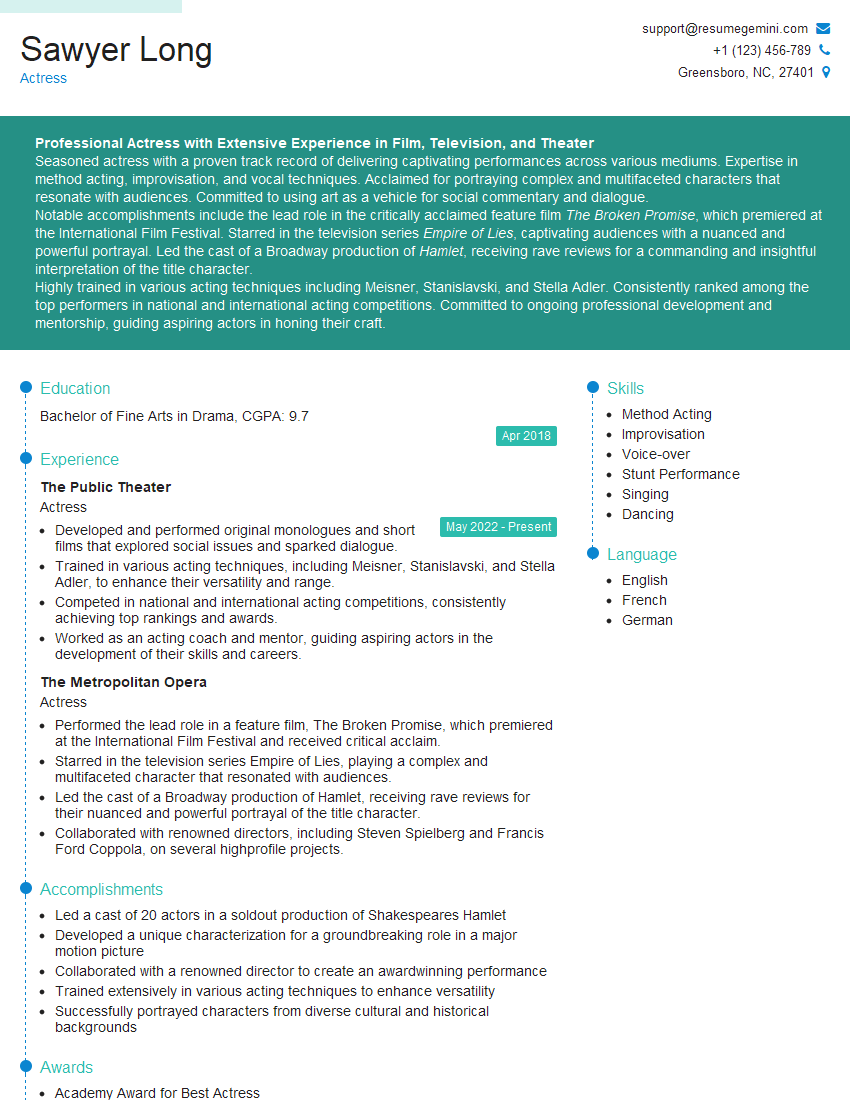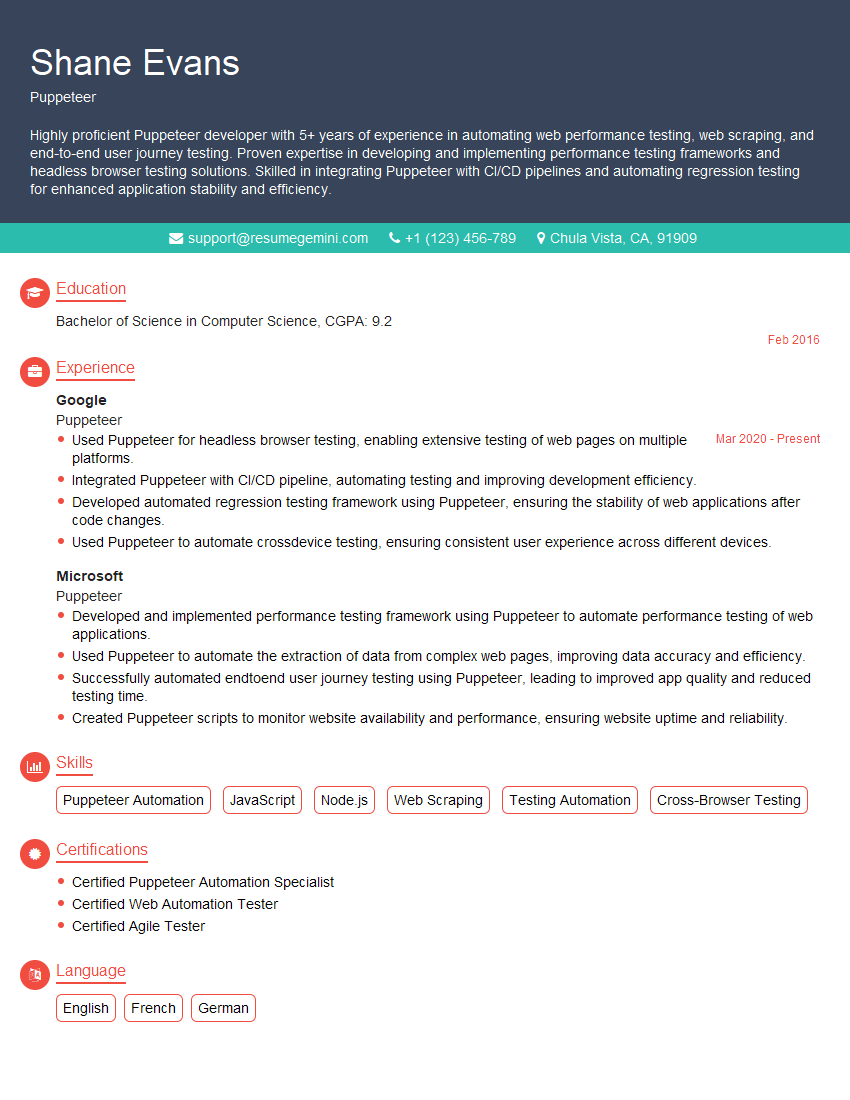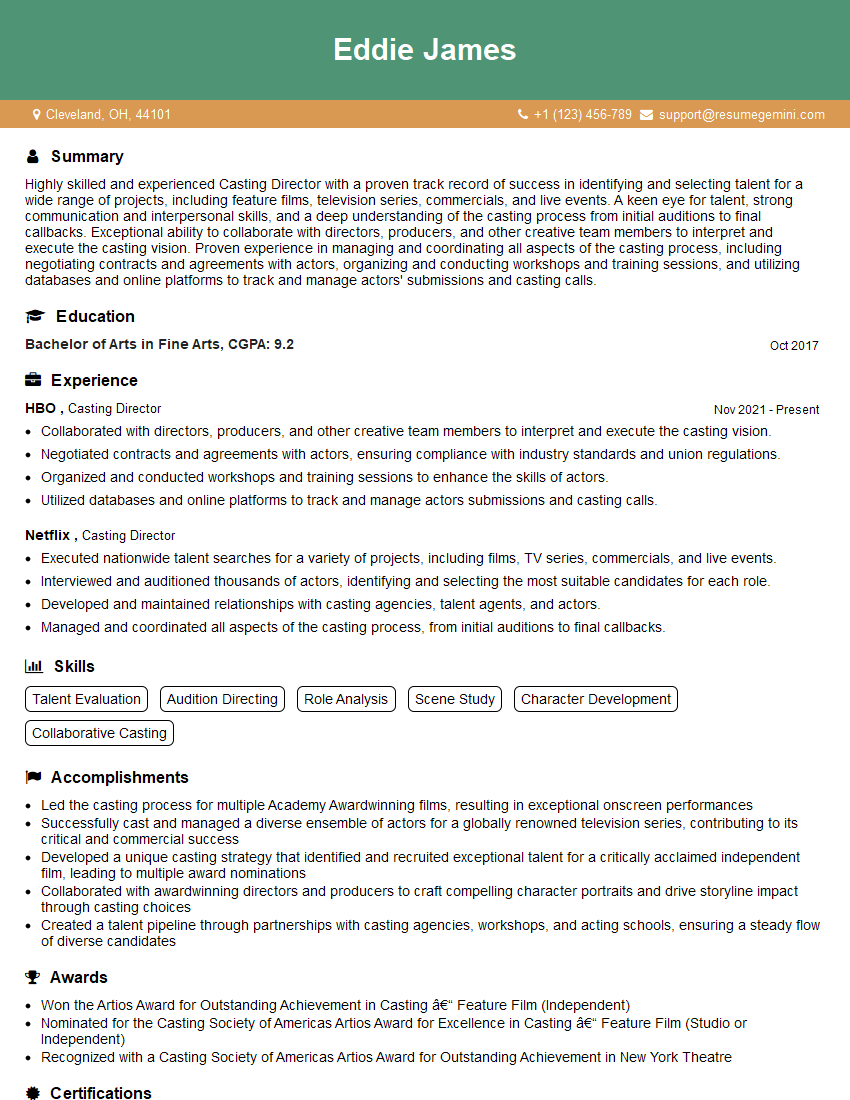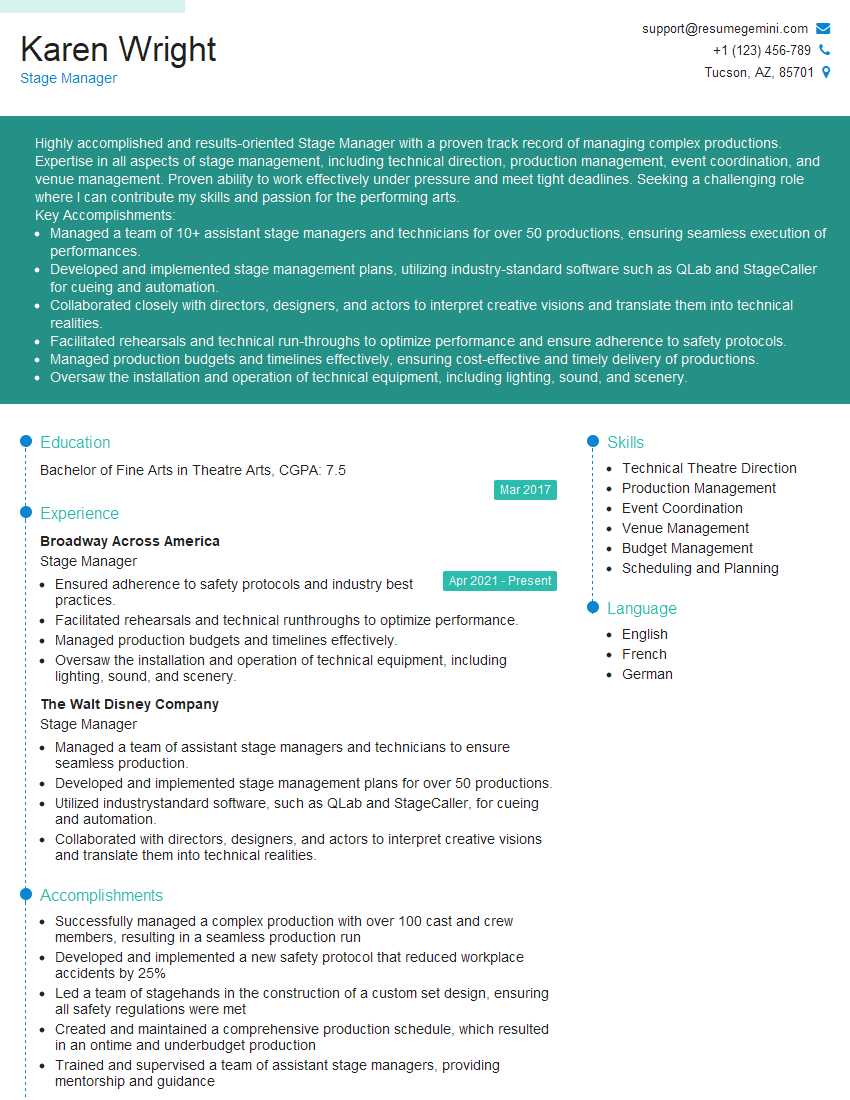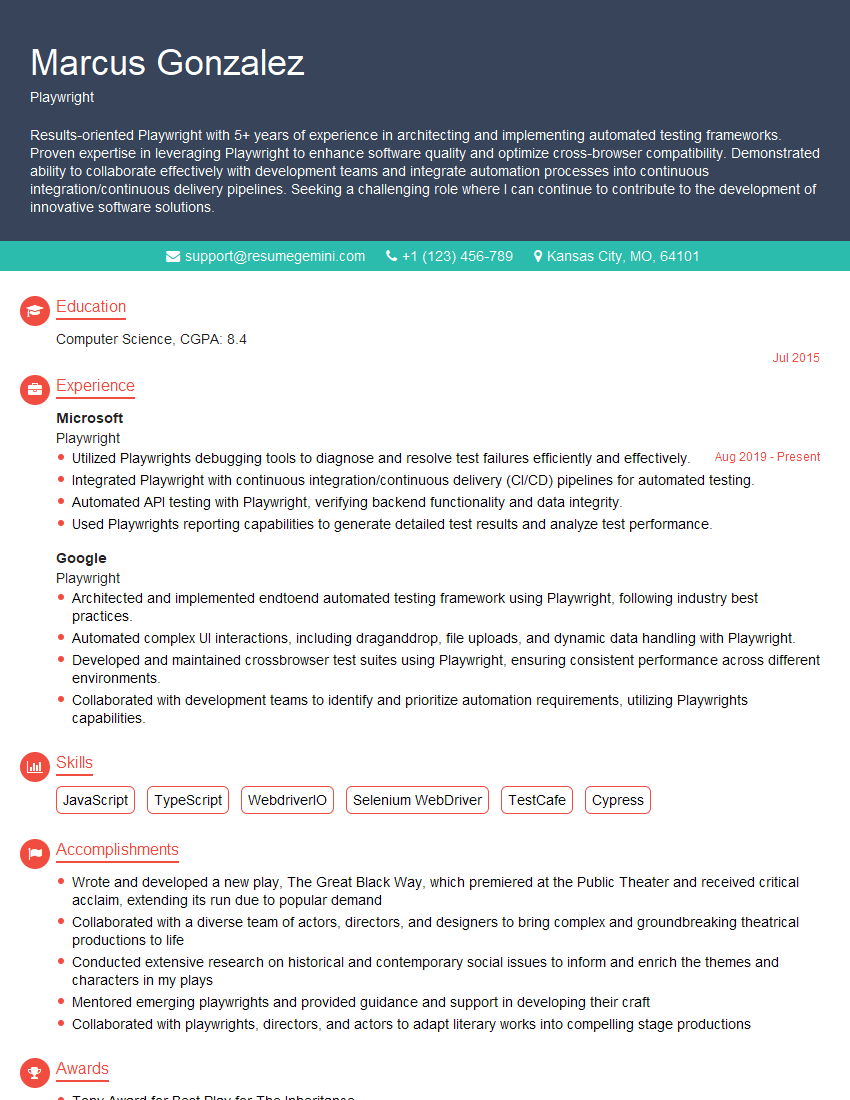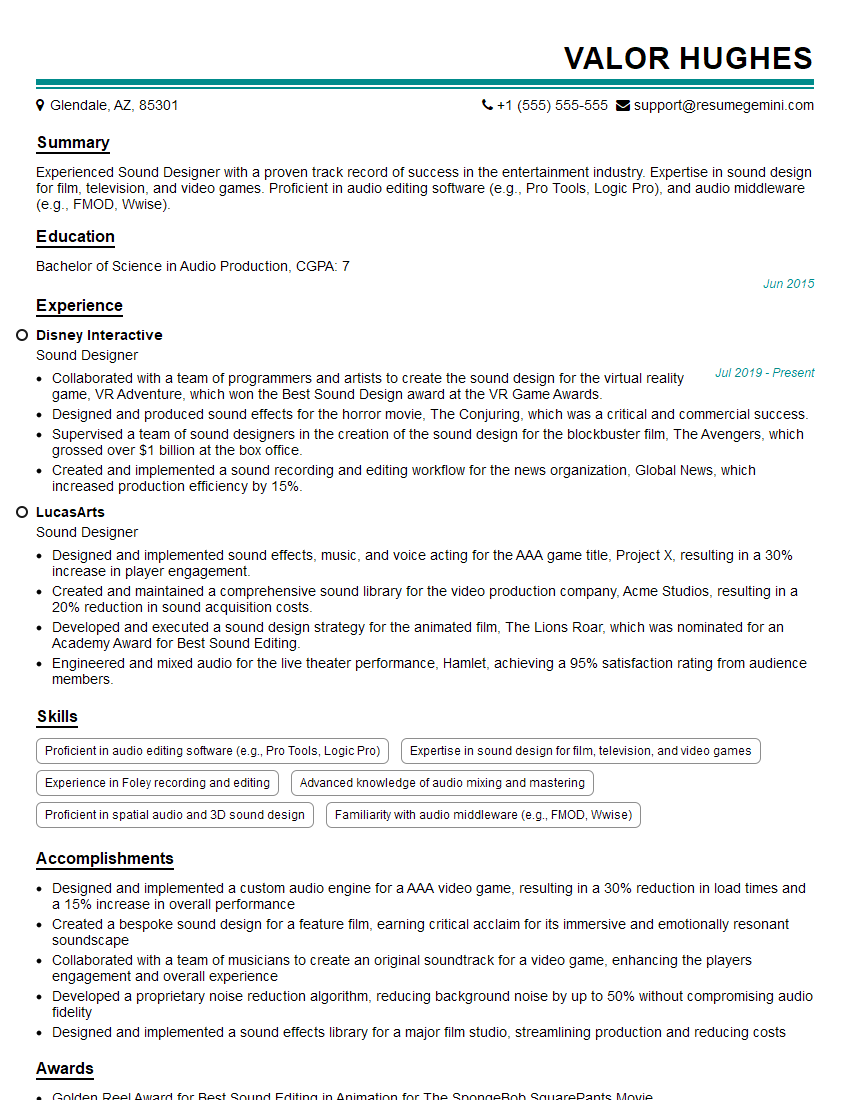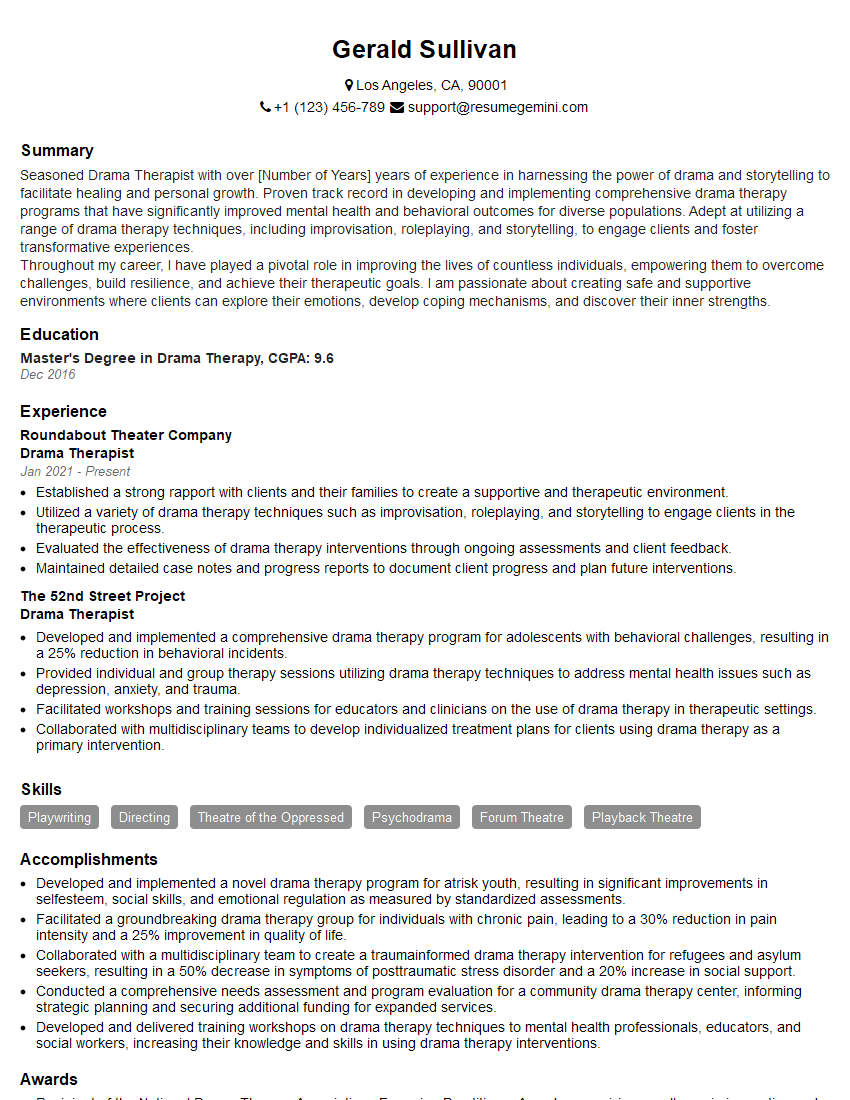Unlock your full potential by mastering the most common Drama interview questions. This blog offers a deep dive into the critical topics, ensuring you’re not only prepared to answer but to excel. With these insights, you’ll approach your interview with clarity and confidence.
Questions Asked in Drama Interview
Q 1. Explain your understanding of dramatic structure (e.g., exposition, rising action, climax, falling action, resolution).
Dramatic structure is the foundational framework of a play, guiding the audience through the narrative arc. Think of it as a roadmap for the story’s emotional journey. It typically consists of five key elements:
- Exposition: This introduces the setting, characters, and initial situation. It sets the stage, literally and figuratively, for the conflict to come. Think of the opening scene of Romeo and Juliet, establishing the feud between the Montagues and Capulets.
- Rising Action: This is where the conflict intensifies. Complications arise, suspense builds, and the stakes get higher. In Hamlet, this includes Hamlet’s discovery of his father’s murder and his subsequent plotting for revenge.
- Climax: The point of highest tension and the turning point of the story. This is where the conflict reaches its peak and often involves a decisive action. The duel between Hamlet and Laertes is a powerful climax.
- Falling Action: The events following the climax, where the consequences of the climax unfold. The loose ends begin to tie up. In Macbeth, after Macbeth’s defeat, the restoration of order begins.
- Resolution (or Denouement): The final outcome of the play. The conflicts are resolved (or not), and a sense of closure is achieved. The final scene of A Midsummer Night’s Dream, with the wedding and reconciliation, offers a classic resolution.
Understanding dramatic structure is crucial for both playwrights and directors as it ensures a compelling and coherent narrative experience for the audience.
Q 2. Describe your experience with different theatrical styles (e.g., realism, absurdism, naturalism).
My experience spans various theatrical styles, each demanding a unique approach to acting, directing, and design.
- Realism: I’ve worked extensively with realistic productions, focusing on portraying believable characters and situations. This involves meticulous attention to detail in set design, costuming, and acting, striving for a sense of verisimilitude. Anton Chekhov’s plays are prime examples, demanding nuanced performances and realistic settings.
- Absurdism: Directing absurdist plays requires a different mindset. The focus shifts from realistic representation to exploring the illogical and nonsensical aspects of human existence. The challenge lies in finding the humor and underlying meaning within the chaos. I found Beckett’s Waiting for Godot particularly challenging and rewarding in this regard.
- Naturalism: Naturalism takes realism a step further, often emphasizing the influence of heredity and environment on human behavior. It demands a keen understanding of social contexts and character psychology. Plays by Henrik Ibsen often exemplify this style, demanding deeply researched and authentic portrayals.
Each style presents its own set of creative challenges and rewards, demanding adaptability and a deep understanding of theatrical history and theory.
Q 3. How would you approach directing a play with a challenging or ambiguous script?
Directing a play with a challenging or ambiguous script requires a collaborative and interpretive approach. My process would involve:
- Deep Dive into the Text: Multiple readings, analysis of subtext, and research into the historical and cultural context are crucial. This forms the foundation for understanding the author’s intentions, even if they remain opaque.
- Collaborative Interpretation: Discussions with actors, designers, and other members of the creative team are vital. Brainstorming sessions and exploring different interpretations of ambiguous scenes help shape a cohesive vision.
- Focus on Theme and Character Arcs: Even if the plot is unclear, the play likely explores certain themes or character journeys. Focusing on these elements can provide a structure and direction for the production.
- Embracing Ambiguity: Sometimes, the ambiguity is part of the artistic merit. Instead of trying to force a singular interpretation, the production can embrace the multiplicity of meanings, allowing the audience to draw their own conclusions.
- Experimentation and Refinement: Rehearsals become crucial for experimenting with different approaches, gathering feedback, and making adjustments. The process is iterative, allowing for organic development of the production.
Ultimately, directing a challenging script is a journey of discovery, demanding creativity, flexibility, and a willingness to embrace uncertainty.
Q 4. Discuss your experience with actor coaching and providing constructive feedback.
Actor coaching is a cornerstone of my directing philosophy. It’s a collaborative process centered on helping actors realize their full potential within the specific demands of the role and the production’s overall vision. I approach it with:
- Active Listening and Observation: I closely observe each actor’s work, paying attention to their strengths, weaknesses, and interpretations. This informs my feedback and coaching.
- Constructive Feedback: My feedback is always specific, focused, and supportive. Instead of general critiques, I pinpoint specific areas for improvement, offering concrete suggestions. For example, instead of saying “your performance is flat,” I might suggest, “Let’s try exploring the character’s underlying anger by focusing on your breath and physicality during this scene.”
- Exploration and Experimentation: I encourage actors to experiment with different approaches, offering guidance and support. The rehearsal room becomes a safe space for risk-taking and discovery.
- Building Confidence: My aim is to empower actors, fostering confidence and a sense of ownership over their roles. This leads to more authentic and engaging performances.
Ultimately, successful actor coaching requires empathy, patience, and a deep understanding of both acting techniques and the specific demands of the play.
Q 5. Explain your process for designing a stage set, considering both practical and aesthetic factors.
Designing a stage set is a multifaceted process that blends artistic vision with practical considerations. My process typically involves:
- Reading and Interpretation: A thorough reading of the script, analyzing its themes, setting, and atmosphere, is the first step. This informs the overall aesthetic and functional requirements of the set.
- Conceptualization and Sketching: I develop initial concepts through sketches, mood boards, and model building. This allows for visual exploration and refinement of the design.
- Technical Considerations: This stage involves practical considerations like budget, available space, construction feasibility, and lighting and sound integration. It often requires collaboration with the technical director.
- Materials and Construction: Choosing appropriate materials that align with the aesthetic and functional needs of the set is critical. This includes considering factors like durability, cost, and ease of construction.
- Refinement and Collaboration: Constant refinement and collaboration with the director, lighting designer, and other members of the creative team ensure the set aligns with the overall artistic vision.
For example, designing a set for a naturalistic play might involve creating a realistic representation of a specific location, whereas an absurdist play might require a more abstract and symbolic set design. The process always prioritizes a cohesive and impactful theatrical experience.
Q 6. How do you manage conflicts within a theatrical production team?
Conflict is inevitable in any collaborative project, including theatrical productions. My approach to managing conflict emphasizes open communication, mutual respect, and a focus on finding solutions that benefit the production as a whole.
- Open Communication: I encourage team members to express their concerns openly and respectfully. Creating a safe space for dialogue is crucial.
- Active Listening: I actively listen to all perspectives, seeking to understand the root causes of the conflict before jumping to solutions.
- Mediation and Facilitation: If necessary, I act as a mediator, facilitating constructive dialogue and helping the team find common ground. My role is to guide the conversation towards a resolution, not to impose a solution.
- Focus on Shared Goals: I constantly remind the team of our shared goal – creating a successful and impactful production. This helps refocus the energy on collaboration and problem-solving.
- Compromise and Collaboration: Often, finding solutions requires compromise from all parties involved. I encourage team members to work together, finding creative solutions that address everyone’s concerns.
My philosophy centers on turning conflict into an opportunity for growth and stronger collaboration.
Q 7. What software or tools are you proficient in for theatrical design or production?
Proficiency in relevant software and tools is essential for efficient and effective theatrical design and production. I am proficient in:
- Autodesk AutoCAD: For precise drafting and technical drawings of sets, ensuring accurate dimensions and construction details.
- Vectorworks: For 3D modeling and rendering, allowing for visualization of set designs and exploration of different design options.
- SketchUp: For quick prototyping and 3D visualization, facilitating rapid iteration and collaboration with the design team.
- Adobe Photoshop and Illustrator: For creating visual aids, mood boards, and detailed renderings to effectively communicate design ideas to the team and stakeholders.
- Microsoft Office Suite: For project management, budgeting, scheduling, and communication.
My technical skills enable me to translate artistic vision into practical and efficient production plans.
Q 8. Describe your experience with stage lighting techniques and their impact on a production.
Stage lighting is more than just illuminating the actors; it’s a powerful storytelling tool. It dictates mood, reveals character, and guides the audience’s focus. My experience spans various techniques, from the classic use of spotlights to create dramatic emphasis, to the more nuanced application of gels to evoke specific emotions. For instance, a cool blue light can create a sense of coldness and isolation, while warm amber lighting might signify comfort and intimacy. I’ve worked extensively with Gobos (metal stencils that project patterns onto the stage) to create evocative settings, and with moving lights to follow actors and enhance dynamism. In one production of Hamlet, we used a stark, single spotlight to isolate Hamlet during his soliloquies, highlighting his internal struggles, while a more diffuse wash of light bathed the court scenes in a sense of oppressive grandeur.
The impact of lighting is profound. Consider a scene where a character reveals a dark secret. A sudden shift to harsh, shadow-filled lighting can dramatically enhance the tension and underscore the gravity of the confession. Conversely, a slow fade to black can create a powerful, lingering sense of finality. I always work closely with the director and the lighting designer to ensure the lighting choices effectively complement the overall narrative arc.
Q 9. How do you handle technical difficulties during a live performance?
Technical difficulties are, unfortunately, an unavoidable reality of live performance. My approach is threefold: prevention, preparedness, and problem-solving. Prevention involves rigorous pre-show checks of all equipment and a thorough rehearsal process that includes technical run-throughs. Preparedness means having backup equipment readily available and a team that understands troubleshooting procedures. Finally, problem-solving involves quick thinking and collaboration. If a light fails during a performance, for example, I’ll immediately communicate with the lighting operator to assess the situation and find an alternative solution, perhaps using a backup fixture or adjusting the existing lighting design to compensate for the loss. The key is to remain calm and react decisively, minimizing disruption to the performance while maintaining the integrity of the artistic vision. During a production of A Midsummer Night’s Dream, a sudden power surge affected the sound system. We instantly switched to pre-recorded music for the next scene, allowing the actors to seamlessly continue the performance while our technician quickly resolved the issue.
Q 10. Explain your understanding of sound design and its role in enhancing storytelling.
Sound design is the unsung hero of many productions. It’s more than just amplifying actors’ voices; it shapes the emotional landscape, builds suspense, and deepens the audience’s connection with the narrative. I understand the intricate relationship between music, sound effects, and dialogue in creating a cohesive soundscape. For example, the use of ambient sounds – the creaking of a door, the rustling of leaves – can establish atmosphere and realism. A sudden burst of jarring sound effects can create surprise or fear. Music can underscore emotional moments, guiding the audience’s feelings and understanding of the characters’ journeys. In a production of Macbeth, we used ominous, low-frequency sounds during the witches’ scenes to amplify the sense of foreboding, while lighter, more whimsical music accompanied the less intense scenes.
Effective sound design is about subtlety and precision. It’s about creating a soundscape that is not distracting but rather enhances and supports the narrative, subtly shaping the audience’s experience without being obtrusive.
Q 11. Discuss your familiarity with different theatrical performance spaces and their implications for staging.
Familiarity with different theatrical spaces is crucial. Each venue presents unique challenges and opportunities for staging. A proscenium arch theatre, with its traditional audience-stage configuration, allows for elaborate sets and traditional staging techniques. In contrast, a thrust stage, which extends into the audience, creates a more intimate and immersive experience, requiring creative solutions for set design and actor movement. Black box theatres, with their flexible configurations, allow for greater experimentation and non-traditional staging choices. I’ve worked in all these types of venues and adapted my approach accordingly. For example, in a proscenium arch theatre, I might utilise grand set pieces and elaborate lighting to create a spectacular visual experience, while in a black box theatre, I might focus on creating a more intimate, minimalist aesthetic.
Understanding the acoustics of a space is also vital. A large proscenium arch theatre might require amplified sound, while a smaller, more intimate space might not. This understanding informs all decisions related to set design, sound design, and actor placement.
Q 12. How do you ensure accessibility in your theatrical productions?
Accessibility in theatre is paramount. It’s about ensuring that everyone, regardless of ability, can enjoy and participate in the production. This involves multiple layers. Firstly, providing audio description for visually impaired audience members, providing captioning for the hearing impaired, and offering wheelchair accessible seating are essential. Secondly, considering the needs of audience members with cognitive impairments requires clear and concise program notes, sensory-friendly performances (reduced sound and lighting effects), and potentially providing a quiet space for those who might feel overwhelmed. Thirdly, casting actors with disabilities and showcasing diverse representation in our productions is a commitment to inclusion, not just as a matter of policy, but as a reflection of the diverse community we aim to serve. In a recent production, we partnered with local disability organizations to ensure that our accessibility measures were effective and met the needs of our diverse audience.
Q 13. Explain your approach to casting actors for a specific role.
Casting is a critical aspect of theatre production. My approach is to prioritize finding actors who embody the spirit and essence of the character, rather than just matching a physical description. I start by thoroughly analyzing the script to understand the character’s motivations, relationships, and journey. Then, I look for actors who possess the necessary skills, both technically and emotionally, to bring that character to life. Auditions are crucial, and I use a multi-stage process, often involving cold readings, prepared monologues, and sometimes even improvisational exercises to evaluate an actor’s versatility and ability to work collaboratively.
I also consider factors like the actor’s experience and chemistry with other cast members. The ideal cast works together harmoniously, supporting each other creatively. Sometimes, I might cast against type, choosing an actor who might not immediately seem to fit the role, but who possesses an unexpected quality that could bring a fresh perspective to the character. The goal is to create a dynamic ensemble that can create a compelling and believable portrayal of the play.
Q 14. Describe your experience with different types of stage makeup and their application.
My experience with stage makeup encompasses a wide range of techniques and products, from the basic application of foundation and powder to the more advanced creation of special effects. I’m proficient in creating both realistic and stylized looks, adapting my approach to the specific needs of the production and the character. For example, creating realistic aging effects for an older character might involve techniques like stippling and applying age lines with careful shading and highlighting, while creating a fantastical creature might involve prosthetics, latex appliances, and specialized paints.
Understanding the properties of different makeup products is essential. Knowing which products are best for different skin types and which will stay put under stage lighting is vital. I’m also familiar with various safety precautions, such as allergy testing and proper sanitation, to ensure the actors’ well-being and a smooth production run. The right makeup can dramatically transform an actor’s appearance, enhancing the character’s personality and contributing significantly to the overall visual impact of the production.
Q 15. How do you manage a budget for a theatrical production?
Managing a theatrical production budget requires meticulous planning and detailed tracking. It’s like building a house; you need a blueprint (budget) before you start laying the foundation (pre-production). I typically begin by identifying all potential costs, categorized for clarity. This includes:
- Pre-production: Script acquisition/writing, set design, costume design, casting, marketing materials.
- Production: Rehearsal space rental, set construction, costume creation/rental, lighting/sound equipment rental or purchase, technical crew salaries, actor salaries/fees.
- Post-production: Marketing and advertising (including digital and print), potential royalty payments, program printing, closing night party.
Once these costs are estimated, I create a spreadsheet to track income and expenses, regularly updating it throughout the production process. This allows for real-time monitoring and adjustment. Contingency funds are crucial – unexpected repairs or delays are common. Securing funding through grants, sponsorships, or ticket sales is equally important, and I often explore multiple avenues to secure adequate financing. Regular budget meetings with the production team are essential to ensure everyone is aware of the financial standing and potential adjustments needed.
Career Expert Tips:
- Ace those interviews! Prepare effectively by reviewing the Top 50 Most Common Interview Questions on ResumeGemini.
- Navigate your job search with confidence! Explore a wide range of Career Tips on ResumeGemini. Learn about common challenges and recommendations to overcome them.
- Craft the perfect resume! Master the Art of Resume Writing with ResumeGemini’s guide. Showcase your unique qualifications and achievements effectively.
- Don’t miss out on holiday savings! Build your dream resume with ResumeGemini’s ATS optimized templates.
Q 16. What are your strategies for marketing and promoting a theatrical production?
Marketing and promoting a theatrical production requires a multi-pronged approach, combining traditional and digital strategies. Think of it as creating a buzz around the show, enticing potential audiences. My strategies typically include:
- Digital Marketing: A well-designed website, targeted social media campaigns (Facebook, Instagram, Twitter), email marketing to build anticipation, online ticket sales, potentially influencer marketing.
- Traditional Marketing: Print advertisements in local newspapers and magazines, posters and flyers in high-traffic areas, collaborations with local businesses and community organizations, radio ads.
- Public Relations: Press releases to local media outlets, reaching out to theatre critics, organizing media previews.
- Community Engagement: Offering discounts for students and seniors, partnering with local schools and community groups for outreach programs.
Crucially, the marketing strategy must be tailored to the specific target audience and the nature of the play itself. A Shakespearean tragedy will necessitate a different marketing approach than a contemporary comedy. Data analysis is key to understanding what works and refining future campaigns.
Q 17. How do you assess the success of a theatrical production?
Assessing the success of a theatrical production is multifaceted and goes beyond just box office numbers. While ticket sales are a key indicator, a holistic approach is essential. I consider several factors:
- Financial Success: Did the production break even or turn a profit? This often dictates future productions’ feasibility.
- Audience Reception: Audience reviews (both online and word-of-mouth), audience satisfaction surveys, and the overall energy of the audience during performances are valuable indicators. Did the play resonate with the audience?
- Critical Acclaim: Reviews from theatre critics can significantly impact future productions and public perception. Constructive criticism can help improve future performances.
- Artistic Achievement: Was the artistic vision successfully realized? Did the production meet the creative goals set by the director and artistic team? This is a subjective yet important assessment.
A successful production is often a combination of these factors. A show could be artistically brilliant but financially unsuccessful, or vice versa. The overall assessment should strive for a balanced view.
Q 18. Discuss your experience with playwriting or scriptwriting.
My experience with playwriting spans several years and diverse projects. I’ve written both original works and adaptations, focusing on character development and exploring themes of social justice and human relationships. One of my original plays, The Weight of Silence, explored the impact of intergenerational trauma within a family. The process involved extensive research, character sketching, plot outlining, and numerous revisions to hone the script. I find the collaborative process particularly enriching; working with actors and directors provides invaluable feedback that shapes the final product. Adapting existing works has challenged me to reinterpret the source material for a specific audience or performance setting, often involving streamlining dialogue or altering the setting. This requires a deep understanding of both the original text and the context of the new presentation.
Q 19. Explain your understanding of dramatic irony and its effect on an audience.
Dramatic irony occurs when the audience has knowledge that the characters on stage lack. This creates a powerful effect, often leading to suspense, humor, or tragedy. For example, in Shakespeare’s Romeo and Juliet, the audience knows that Juliet is merely sleeping, not dead, while Romeo believes she is deceased. This creates immense tension because we anticipate the tragic consequences of his actions, while Romeo remains oblivious. The effect on the audience is heightened engagement and emotional investment. We become complicit witnesses, experiencing a range of emotions as the characters unknowingly move towards their fate. This heightened awareness enhances the dramatic impact of the scene, allowing for a deeper understanding of the characters’ motivations and the play’s themes.
Q 20. How would you adapt a play for a different audience or performance space?
Adapting a play for a different audience or performance space necessitates careful consideration of several aspects. Imagine adapting a large-scale production, originally designed for a Broadway theatre, to a smaller, intimate setting. This might involve:
- Set Design Simplification: Large, elaborate sets may need to be scaled down or replaced with more minimalist designs to fit the smaller space.
- Script Condensation: Certain scenes or dialogues might need to be shortened or eliminated to maintain pacing and ensure a suitable runtime for the new space.
- Character Adjustments: Minor alterations to character development might be necessary to adapt to the different audience’s sensibilities or cultural context.
- Technological Adaptations: The use of lighting and sound effects must be adapted to the specifics of the new venue.
Adapting for a different audience (e.g., from adults to children) might involve simplifying language, altering plot points for younger audiences, or adding elements of humor or music to increase engagement. The key is to find a balance between staying true to the original work and making it relevant and accessible to the new target group.
Q 21. Describe your experience with collaborative storytelling.
Collaborative storytelling is fundamental to theatrical production. It’s a collective effort that involves actors, directors, designers, writers, and the entire production team. My experience in collaborative storytelling highlights the importance of open communication, mutual respect, and a shared vision. In one production, we used a ‘brainstorming’ session with actors to enrich character development. Their insights into character motivations and backstories significantly enhanced the depth and authenticity of the play. This collaborative approach fosters creativity and yields a richer, more nuanced final product. It’s not simply about individual contributions; it’s about weaving those contributions together to create something greater than the sum of its parts. The collaborative process requires active listening, constructive feedback, and a willingness to compromise and adjust ideas to achieve a cohesive artistic vision.
Q 22. Explain your understanding of character development and motivation.
Character development and motivation are the cornerstones of compelling drama. Character development is the process of creating a believable and evolving individual within the narrative. This involves crafting their backstory, personality traits, relationships, desires, and flaws. Motivation, on the other hand, is the driving force behind a character’s actions – their wants, needs, and goals that propel the plot forward.
Think of it like this: development is the who of the character (their inherent qualities and how they change), and motivation is the why (the reasons for their actions). A well-developed character with clear motivations feels authentic and relatable to the audience. For instance, Hamlet’s desire for revenge (motivation) drives his complex internal struggles and ultimately shapes his tragic downfall (development). A poorly developed character, conversely, feels flat and unconvincing.
- Backstory: Exploring a character’s past experiences shapes their present actions and beliefs.
- Relationships: How a character interacts with others reveals their personality and motivations.
- Obstacles: The challenges faced by the character reveal their strengths and weaknesses, further driving the plot.
- Arc: A character’s journey throughout the play, from beginning to end, showcases their development.
Q 23. How do you use improvisation techniques in your work?
Improvisation is invaluable in my work, fostering spontaneity and creativity. I use it in several ways: during rehearsals to explore character nuances, discover unexpected comedic or dramatic possibilities, and help actors find organic responses to each other. It’s particularly beneficial when working with ensemble pieces where collaborative storytelling is key.
For example, I might suggest a scene prompt – ‘You discover your roommate has mysteriously vanished’ – and encourage actors to improvise the scene, building upon each other’s actions and dialogue. This allows them to uncover hidden dimensions within their characters, and to develop a stronger ensemble dynamic. The best improvisations often inform the final script, providing unexpected depth and authenticity. It also builds trust and collaboration amongst the cast.
Q 24. Discuss your experience with different methods of acting (e.g., Stanislavski, Meisner).
My approach to acting draws upon various methods, integrating the strengths of each. Stanislavski’s system, focusing on emotional recall and ‘living truthfully’ under imaginary circumstances, is crucial for accessing deep emotional layers. I encourage actors to connect with their personal experiences to create authentic portrayals. The Meisner technique, emphasizing ‘living the circumstances’ and reacting truthfully to one’s partner, helps build strong relationships between characters on stage and fosters natural interactions.
For instance, in a production of Chekhov, I’ve used Stanislavski’s techniques to help actors delve into the nuanced emotions of the characters. In contrast, during a fast-paced comedy, the Meisner technique helped actors to react spontaneously and authentically to their scene partners, creating truly hilarious and unpredictable moments.
Beyond these, I also incorporate elements of other techniques – like voice and movement training – to create a holistic and versatile acting approach for each production.
Q 25. How do you incorporate audience engagement into your productions?
Audience engagement is vital for creating a truly immersive theatrical experience. I strive to break the ‘fourth wall’ subtly, inviting the audience to become active participants rather than passive observers. This might involve incorporating interactive elements, using direct address, or crafting productions with a conversational tone. Sometimes, simple choices such as stage placement and lighting can draw the audience directly into the action.
For instance, in a recent production, we used audience participation during a crucial scene. The actors directly addressed audience members, prompting reactions and incorporating their responses into the unfolding narrative. In a more subtle approach, we used immersive sound design and lighting to create an atmosphere that brought the audience into the emotional space of the play. This fostered a palpable connection between the performers and the spectators.
Q 26. Describe your experience with stage combat or movement choreography.
I have extensive experience collaborating with stage combat and movement choreographers. Incorporating fight scenes or elaborate movement sequences requires meticulous planning, ensuring the safety of actors while creating a visually compelling and believable performance. This begins with careful rehearsals and a thorough understanding of both the narrative context and the physical capabilities of the actors.
I work closely with choreographers to design fights that are both safe and dramatic. This includes detailed blocking, the use of appropriate weaponry (if any), and the careful application of specific techniques designed to create the illusion of violence without actual harm. A well-choreographed fight scene not only enhances the visual spectacle but adds a layer of tension and excitement to the story.
Q 27. Explain your understanding of theatrical conventions and their historical context.
Theatrical conventions are the unspoken rules and techniques that govern theatrical performances. These conventions have evolved throughout history, reflecting the changing aesthetics and technologies of each era. Understanding these conventions is crucial for both creating and interpreting dramatic works.
Examples include the use of the aside (a character speaking directly to the audience while other characters remain unaware), soliloquies (a character’s extended speech revealing their inner thoughts), and the breaking of the fourth wall (when characters acknowledge the audience’s presence). The use of masks in Greek tragedy, for instance, was a convention that significantly impacted the performance style and audience’s experience. Studying the historical context helps us understand why these conventions arose and how they shaped theatrical traditions.
- Ancient Greek Theatre: Use of chorus, masks, and open-air amphitheaters.
- Shakespearean Theatre: Use of iambic pentameter, soliloquies, and cross-dressing.
- Modern Theatre: Breaking of the fourth wall, experimental staging, and diverse performance styles.
Understanding these conventions allows for both informed interpretations and innovative departures from established norms. A modern production might deliberately break with a convention, creating a powerful effect.
Q 28. How would you resolve a disagreement between actors during rehearsal?
Resolving disagreements among actors requires a collaborative and diplomatic approach. My first step is to facilitate open communication, creating a safe space for actors to express their concerns. I encourage active listening and empathy, aiming to understand the perspectives of each individual involved. The goal is to identify the root cause of the disagreement, separating personal feelings from artistic choices.
Once the issues are understood, I facilitate a discussion where actors can collaboratively find solutions that satisfy everyone while staying true to the overall artistic vision. Sometimes, compromise is necessary, and other times, a clear and consistent artistic direction helps to realign the actors’ efforts. If the disagreement persists, I might involve a mediator, ensuring a fair and constructive resolution.
Ultimately, fostering a respectful and professional environment is key. When actors feel heard and valued, they’re more likely to be open to collaboration and finding solutions together.
Key Topics to Learn for Your Drama Interview
- Acting Techniques: Explore various acting styles (e.g., Stanislavski, Meisner, Brecht) and their practical application in different performance contexts. Be prepared to discuss your preferred methods and why.
- Dramatic Theory: Understand key theoretical concepts like dramatic structure (exposition, rising action, climax, etc.), character development, and dramatic irony. Consider how these theories inform your own performance choices.
- Directing and Stagecraft: Discuss your understanding of directing techniques, stage management, set design, and lighting. Even if not directly your focus, a broad understanding demonstrates a holistic approach to theatre.
- Script Analysis: Showcase your ability to dissect a script, identify key themes, understand character motivations, and analyze dramatic tension. Practice analyzing scenes and discussing your interpretations.
- Performance Practice: Be prepared to discuss your experience with vocal projection, physicality, improvisation, and ensemble work. Highlight instances where you’ve overcome challenges or adapted your performance.
- Collaborative Work: Emphasize your teamwork skills and collaborative experiences. Discuss how you’ve contributed to a successful team performance and resolved conflicts constructively.
Next Steps: Unlock Your Dramatic Potential
Mastering the art of drama opens doors to diverse and rewarding careers, from acting and directing to theatre management and arts administration. To maximize your job prospects, a strong, ATS-friendly resume is crucial. ResumeGemini is a trusted resource to help you craft a compelling and effective resume that highlights your unique skills and experience. We provide examples of resumes tailored specifically to the drama field to help you get started. Take the next step towards your dream career – build your best resume yet with ResumeGemini.
Explore more articles
Users Rating of Our Blogs
Share Your Experience
We value your feedback! Please rate our content and share your thoughts (optional).
What Readers Say About Our Blog
Hi, I’m Jay, we have a few potential clients that are interested in your services, thought you might be a good fit. I’d love to talk about the details, when do you have time to talk?
Best,
Jay
Founder | CEO

